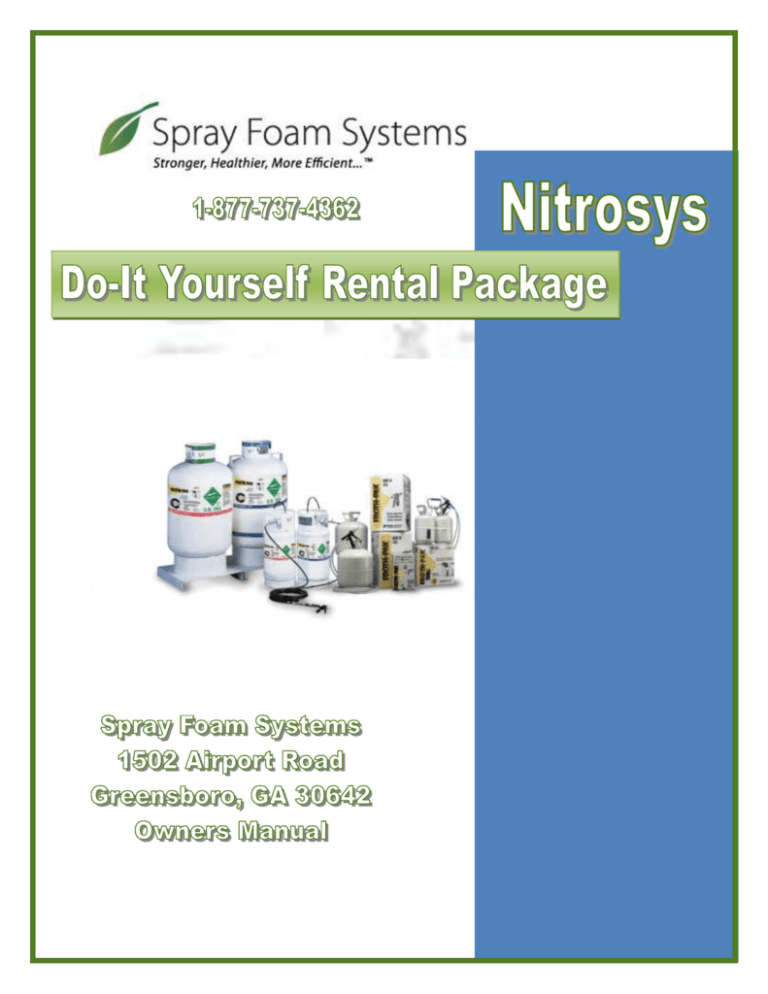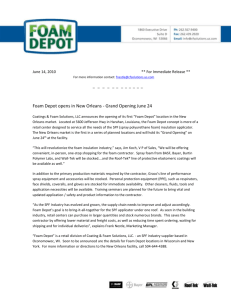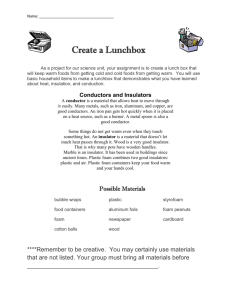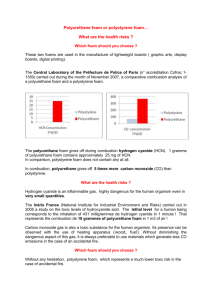User Manual
advertisement

SPRAY FOAM SYSTEMS: NITROSYS: Do-It Yourself Start Up Procedures Before You Start Pre-Heating Your Tanks 4 Transporting Your Tanks 4 Pressurizing the System Connecting your Nitrogen Regulators 4 Attaching your Nitrogen Hoses 5 Attaching your Chemical Hoses Polyfoam Insul-Seal Dow Chemical Company/Polyfoam Products Insul-Seal 5 6 Fomo Products Handi-Foam 6 Spritzer Agricultural Foam 6 Pressurizing 7 Calibrating Weighing and Dividing 8 Testing for Good Foam 9 Spraying Foam and Using the Purge System Getting Started Preparing to Spray 10 Spraying Foam 10 Techniques for Spraying Foam 10 Spray Foam Systems: Nitrosys Owner’s Manual Page 2 Shut Down Procedures Daily Shutdown Shutting Down the System 11 Temperature Control Heating or Cooling the Rig 12 Temperature Effects 12 *Diagram A Maintenance Gun Maintenance Preparing the Gun for Spraying 13 Cleaning the Gun Interior 13 Assembling the Gun 13 Miscellaneous Maintenances Upkeep of the System 14 Safety Safety Supplies Suiting Up to Spray 14 Isocyanate Safety 14 Troubleshooting Spray Foam Systems: Nitrosys Owner’s Manual 15 Page 3 Dear Valued Customer, Thank you for purchasing the Do it Yourself Rental Package. This manual will guide you step-by-step through your project and tell you everything you need to know from starting up your system, to spraying foam and cleaning up. If there are any additional needs or you need live technical service, please feel free to call our Customer Service line at 1-877-737-4362. Start Up Procedures I. II. Before You Start: A. Pre-Heating Your Tanks 1. In order for your system to operate most efficiently, the chemical must be preheated to as close to 90 degrees as possible. 2. In order to achieve this degree of temperature, store your tanks in a warm environment such as a heated garage or a hot-box. 3. If you do not have a garage, a hot-box is the most efficient way to heat the tanks. B. Transporting Your Tanks 1. The tanks come equipped with a steel footer for transporting. It is best to use a forklift or pallet jack to move the tanks. 2. Do Not turn the tanks over and roll them! Pressurizing the System A. Connecting your Nitrogen Regulators *Two bottles of Nitrogen will be needed to pressurize your system. You can find bottles at your local welding store. 1. Strap in your Nitrogen bottles to a safe, sturdy structure. If there is no structure, attach the bottles to your Foam Tanks. 2. Remove your two high performance regulators from the package. Upon opening and before installing the regulators on the tanks, ensure that both dials are backed all the way out (counterclockwise). 3. Remove safety caps from the dry nitrogen bottles and store them in your package. 4. Install your regulators on each bottle. Make sure that the regulator is tight. Do not over tighten! Spray Foam Systems: Nitrosys Owner’s Manual Page 4 B. Attaching your Nitrogen Hoses 1. Locate your nitrogen hoses above your designated nitrogen bottle area. Red hoses are for Isocynate and Blue hoses are for Polyol. 2. Using combo wrenches, attach the Red hose to the bottom of the regulator. Attach the Blue hose to the other regulator. Notice that the fittings are brass JIC fittings. Make sure you do not over tighten. Finger tighten the fitting, then lightly snug it with a wrench. If over tightened, brass JIC fittings could crack. Please use caution. 3. Make your way to the designated area for tank storage. Find your red and blue rubber Nitrogen hoses. Attach the red nitrogen hose to the top of the Isocynate tank. Make sure to attach the hose to the correct fitting. Attach the blue nitrogen hose to the top of the Polyol tank. Again, make sure you are attaching to the correct fitting. Do not over tighten! (For Spritzer and Handi-Foam tanks, please refer to next section on converting your tanks) C. Attaching your Chemical Hoses 1. 3M SFI-175 a. Find the filters supplied in the package b. Remove the filters and examine the filters. Notice the flow direction arrow engraved on the filter. c. Remove the plug, along with the ½” MPT connection on the tank. Install the filter in the ½” FPT connection on the tank. Before removing the plug, ensure that the shut off valve is turned OFF. The valve is off when it is perpendicular to the flow direction. d. Tighten the filter provided on the top of tank to the discharge valve. Ensure that the arrow found on the filter is pointing away from the tank. e. Locate your steel braided hose and attach the female swivel to the filter on the tank. Make sure to tighten well. 2. Dow Chemical Company Tanks a. Find the filters supplied on the top of the tanks inside the cloth bags. b. Remove the filters from the bags and examine the filters. Notice the flow direction arrow engraved on the filter. c. Remove the plug from the chemical discharge valve on the top of the tank. Before removing the plug, ensure that the shut off valve is turned OFF. The valve is off when it is perpendicular to the flow direction. Spray Foam Systems: Nitrosys Owner’s Manual Page 5 d. Tighten the filter provided on the top of tank to the discharge valve. Ensure that the arrow found on the filter is pointing away from the tank. e. Locate your steel braided hose and attach the female swivel to the filter on the tank. Make sure to tighten well. 3. Fomo Products Handi-Foam Tanks a. Locate the provided Fomo-Conversion kit. b. Ensure that all valves on both tanks are turned off. Spray Foam Systems: Nitrosys Owner’s Manual Page 6 c. Attach the conversion kits into the corresponding tanks. Male and Female fittings will prevent from crossing over the tanks. d. For Nitrogen conversion, locate the provided Fomo Nitrogen hoses. Locate the provided #4 JIC adaptor. Connect the Fomo Nitrogen hose to the Nitrogen hose within the trailer with the JIC adaptor. e. The filter is built within the conversion kit. Ensure and double check that the arrow on the filter is pointing away from the tank. f. Locate your steel braided hose and attach the female swivel to the filter on the tank. Make sure to tighten well. 4. Spritzer Agricultural Foam *a minimal 12” adjustable wrench is needed to adjust some Spritzer fittings a. Locate the provided Spritzer-Conversion kit. b. Ensure that all valves on both tanks are turned off. c. Remove the cap from the top of the Spritzer discharge valve. Tighten the Spritzer-Conversion kit onto the top of the tank. Make sure all valves on the conversion kit are turned off. d. For Nitrogen conversion, use the supplied quick-connect and connect to the top of the Nitrogen tank. Tighten the nitrogen hose to the top of the quick connect conversion. Do not over tighten! e. Attach the filter to the top of the conversion kit. Make sure that the flow direction arrow is pointing away from the tank. f. Locate your steel braided hose and attach the female swivel to the filter on the tank. Make sure to tighten well. D. Pressurizing *Before continuing, please make sure all valves are turned OFF within the system. 1. Make sure that your nitrogen regulator dials are backed all the way out and are loose. 2. Slowly open the valve on the top of your nitrogen tanks. Your nitrogen regulator should read around 2000-2500 PSI on the high pressure side if the bottle is full. 3. Different manufacturers have different pressures that the recommend to get to their operating ratio. 3M A side 140 PSI and 3M B side 190 PSI DOW A side 160 PSI and B side 175 PSI FOMO A side 160 PSI and B side 170 PSI Spray Foam Systems: Nitrosys Owner’s Manual Page 7 4. For the isocyante regulator (A SIDE, ISO, RED), set the PSI output by slowly turning the dial on the regulator in the clockwise direction until the regulator reads a recommended PSI on the inner red dial. Do not exceed 200 PSI! 5. For the polyol regulator (B SIDE, POLY, BLUE), set the PSI output by slowly turning the dial on the regulator in the clockwise direction until the regulator reads 170 PSI on the inner red dial. Do not exceed 200 PSI! 6. Locate the nitrogen shutoff valves on the top of you tanks. Open the nitrogen shutoff valves on top of the tanks. This will allow your nitrogen to pressurize the tanks. Do not open chemical discharge shutoff valves! 7. After the tanks are completely pressurized (little or no noise), open the main discharge valve on the top of the tank. Then, open the shutoff valve on the chemical hose. This will allow chemical to be pushed into the hose. 8. Place a calibration nozzle on the tip of your gun. Turn the valve at the gun on the polyol side on and switch the valve on the iso/purge block toward the iso hose. 9. Pull the trigger to purge the air out of the hose. Air will be followed by chemical. Purge all of the air and chemical until it starts to begin to flow in a steady stream. When chemical begins to flow in a steady stream (15-45 seconds of discharge), the hose is now completely pressurized. III. Calibrating A. Weighing and Dividing *Ziploc bags or any container that can be sprayed into simultaneously and not mixed are required for calibrating. 1. You will need a kitchen scale or electronic scale that can measure in grams. Set the scale to grams. 2. Place a calibration nozzle on the gun. Get two Ziploc bags or preferred device for weighing. Surround one bag around the Iso side of the tip, surround the other bag around the Poly side of the tip. Squeeze the trigger until one of the bags is 90% full. Minimal reading of 30 grams is best for calibrating. 3. Place the Iso bag on the scale. (Iso is the darker chemical; brown). Take the weight of your Iso. Spray Foam Systems: Nitrosys Owner’s Manual Page 8 4. Place the Poly bag on the scale. (Poly is the lighter chemical; clear). Take the weight of your Poly. 5. Determine the weight of the Iso and the Poly. Take the weight of the Iso and divide it by the weight of the Poly. This is used to determine the ratio of A parts per B. 6. Dow Chemical Company and Polyfoam 2.0 lb foam has a ratio of 1.00 parts Iso per 1.00 part Polyol. In order to achieve this ratio divide the amount of Iso by the amount of Polyol. 7. Ex. A/B= Ratio A=48grams B=40grams 48g/40g = 1.2 Ratio 1.2 is exactly right! 8. 3M SFI-175 needs a ratio of 1.1 to 1.0 3M EX: A/B Ratio A=44G B=40G 44G/40G=1.1 Ratio 1.1 is exact for 3M 9. Fomo Products Handi-Foam needs a ratio of 1:1. (In order to achieve this ratio you need to take the amount of the A chemical and divide it into the amount of B chemical.) Handi-Foam 1.75 lb closed cell and Handi-Foam Low Density foam are both 1:1 ratio. 10.Ex. A/B= Ratio A=44grams B=44grams 44g/44g = 1.00 or 1:1 ratio 1.0 is OK! 11.If unsuccessful, adjust pressure in accordance to volume needed. If lower than 1.00, increase necessary component. If higher than 1.00, decrease necessary component. Do not exceed 200 PSI when adjusting pressure. B. Testing for Good Foam 1. After achieving the ratio, it is necessary to test foam. 2. Spray onto any surface and wait for foam to react. Watch the foam; it will begin to rise. After 30-45 seconds the foam should be tack free. Substrate temperatures and environmental issues could cause the foam to take longer to become tack free. 3. With closed cell foam, the foam should begin to rise about 30x and form a very hard rigid coating. 4. With open cell foam, the foam should begin to rise about 100x and form a soft squishy coating. Spray Foam Systems: Nitrosys Owner’s Manual Page 9 5. If all is well, the system is completely ready to start spraying foam. 6. If foam does not test out well, recalibrate and test for good foam once more. 7. If foam still does not come out well, refer to the troubleshooting section later in the manual. Spraying Foam Getting Started A. Preparing to Spray 1. Before attempting to spray foam, if at all possible, try to raise the environment and substrate temperatures to 70 degrees or above. 2. Cover all windows, doors, bath tubs, showers, sinks, floors, etc. Anything that does not need to be sprayed needs to be covered. 3. Be aware of all objects surrounding you. Foam particles can travel through the air and stick. Be sure to warn others and ask them to move cars, trailers, tools, etc. B. Spraying Foam 1. Double check that all valves within the system are turned on. 2. Turn the polyol valve at the end of the hose, ON. 3. Turn the iso valve at the end of the hose, ON. 4. Insert a fan tip into the gun. 5. Spray onto the surface. There are different techniques for different substrates and surfaces. Depending on what you are spraying and the amount of space available, techniques can vary. C. Techniques for Spraying Foam 1. Spraying in a stud cavity is one of the most common ways of spraying. 2. When spraying in a stud cavity, start at the bottom of the stud. Slowly work your way up the cavity, from bottom to top, going side to side of the cavity while staying about 12 inches away from the wall. 3. Depending on thickness needed and speed of applier, overlap at least 25% and no more than 75%. Spray Foam Systems: Nitrosys Owner’s Manual Page 10 4. Make sure that your hand stays perpendicular to the surface on which you are spraying. Not staying perpendicular can cause excess buildup and waste of foam. 5. The Picture Frame technique is another technique used to spray. This technique involves outlining the area in which you are spraying, and then filling in the surface area. 6. Touch up spraying is commonly used in all spraying applications. Due to the fact that the gun is fingertip sensitive, lightly pulling the trigger will allow you to touch up in areas that are light or missed. 7. Caulking small gaps and cracks and filling in holes are also two types of techniques that can be used while spraying foam. Inserting the tip of the gun into holes, gaps, or cracks and lightly pulling the trigger will allow you to fill in. 8. Spraying overhead is another technique people use daily. When spraying overhead, try to stay 8-12 inches from the wall to keep overspray light. Use the same technique as spraying in the stud cavity. 9. When spraying, always be sure that you do not spray too far or too close. Spraying too far away will result in a “popcorn” look and loss of yield. Spraying too close will result in blowing foam off the wall and losing a lot of waste. Shut Down Procedures I. Daily Shutdown A. Shutting down the System 1. Make sure all valves on the gun assembly are shut off. Roll up the hose onto a hose rack. 2. Turn off all valves on the Iso tank and the Polyol tank. 3. Turn off the nitrogen regulators by turning the dial counterclockwise. 4. Purge the air from the nitrogen lines by loosening the fitting on the bottom of the nitrogen regulator. 5. Remove the nitrogen regulators from the nitrogen bottle and replace the safety cap. 6. Double check to make sure that all valves are turned off. II. Temperature Control A. Heating or Cooling the System Spray Foam Systems: Nitrosys Owner’s Manual Page 11 1. It is necessary to keep chemicals in a controlled environment as close to 85 degrees Fahrenheit as possible. 2. Depending on the environmental temperature, turn on the heater or air conditioning. 3. It is very important to maintain chemical temperatures. Keep the tanks heated or cooled overnight. B. Temperature Effects 1. The chemical must sprayed at optimum temperatures of 70-90 degress Farenheit in order to achieve maximum results. 2. Please refer to the diagram A below to see effects of poorchemical temperature management. Diagram A Maintenance I. Gun Maintenance A. Preparing the Gun for Spraying 1. Before spraying foam, it is essential to the life of your gun to prepare it for spraying. 2. Apply petroleum jelly to the inside of the gun where the tips are inserted. Be sure there is little or no chemical within the gun before applying the petroleum jelly. 3. Make sure the gun is properly cleaned before spraying. (Proper cleaning techniques will explained later in this section) B. Cleaning the Gun Interior 1. Before attempting to clean the gun, make sure that all pressure is relieved on the gun and that all valves are turned off. Spray Foam Systems: Nitrosys Owner’s Manual Page 12 2. Remove the small metal staple on the side of the gun. 3. Slowly and carefully remove the hose from the back of the gun. 4. Watch closely for the small filter and make sure it does not fall out of the gun. 5. Collect the filter and store it in a safe place. Pull the frother from the interior of the gun. 6. Using DK817 or DPM, clean the frother and the filter screen. Also, clean the interior of the gun. C. Assembling the Gun 1. Replace the frother into the interior of the gun. Be sure that the small orifice on the frother is facing toward the front of the gun. 2. Replace the filter screen on top of the frother. Be sure that there is no trash left on the filter screen. 3. Replace the hose onto the back of the gun. Insert the metal staple and firmly insert it into place. Spray Foam Systems: Nitrosys Owner’s Manual Page 13 II. Miscellaneous Maintenances A. Upkeep of the System 1. Always keep the tanks as warm as possible, especially if chemical is stored outside. 2. Make sure to clean all fittings and keep all fittings in working order. 3. Clean the gun after every use. Safety Spray Foam Systems: Nitrosys Owner’s Manual Page 14 I. Safety Supplies A. Suiting Up to Spray 1. The Tyvek Suit will offer full body protection from head to toe. 2. Nitrile Dipped Gloves will provide full protection on your hands. 3. Half mask respirators will cover your nose and mouth area. Install two cartridges per mask. Masks are good for 48 hours of use. When not using the mask, insert the mask into an airtight plastic bag. This will extend the life of the cartridge. 4. Advanz Safety Goggles will provide you with a full eye protection and 30 advances of film to allow clear vision while spraying. B. Isocyanate Safety 1. Isocyanate is an extremely harmful chemical. Contact to the eyes, skin, mouth, or respiratory system can be very harmful. Exposure to high iso vapor levels or skin contacts with liquids of mists can make you sick. Exposure for even a short time can cause severe irritation of the nose, throat and lungs. Some other symptoms are breathlessness and chest pains. Excessive exposures can result in severe coughing spasms and may lead to bronchitis or chemical pneumonia. These symptoms of overexposure generally clear up in a day or two. The lung capacity of affected individuals may, however be decreased for a longer time. Skin and/or respiratory sensitization can take many months or years to develop. Troubleshooting Common Problems Problem Reason Solution#1 Solution#2 Light color foam, falling off the wall. Too much Polyol, not enough Iso. Adjust pressure on Iso higher. Dark color foam, Too much Iso, Clean out frother and filter on Iso side. Clean out Spray Foam Systems: Nitrosys Owner’s Manual Adjust pressure Page 15 falling off the wall. not enough Polyol. Foam is not frothing, smaller Fan pattern Foam is too cold Continuous blockage in gun filter screen Hose needs cleaning No chemical out of Iso side Iso hose has blockage Can not calibrate or calibration will not work Many Foam is shrinking in the walls Substrate too cold Out of DPM or Pressure Purge system will not work Spray Foam Systems: Nitrosys Owner’s Manual frother and filter on Poly side. Roll up hose and heat it up on Polyol higher. Clean hose with cleaning solution Remove hose and clean hose as much as possible. Double check regulators and tank pressures Warm up substrate Add DPM Replace gun filter screen Ensure tanks are pre-heated properly If hose is completely blocked, replace hose. Call Customer Service Warm up environment Add Pressure Page 16 PART NUMBER 259212 259219 259211 259216 259218 259215 258217 259214 259220 259206 259208 COLOR YELLOW BACK WHITE/BLACK WHITE BACK WHITE BACK GREY BACK GRAY BACK BLACK BACK BLACK BACK BACK BACK BLACK NACK YELLOW BACK Spray Foam Systems: Nitrosys Owner’s Manual OUTPUT LOW OUTPUT MEDIUM OUTPUT MEDIUM OUTPUT MEDIUM OUTPUT HIGH OUTPUT HIGH OUTPUT HIGHEST OUTPUT HIGHEST OUTPUT HIGHEST OUTPUT NOZZLE TYPE CAULKING NOZZLE CONE SPRAY CAULKING NOZZLE FAN SPRAY CONE SPRAY FAN SPRAY CONE SPRAY FAN SPRAY POUR NOZZLE CALIBRATION TIPS CALIBRATION TIPS Page 17







